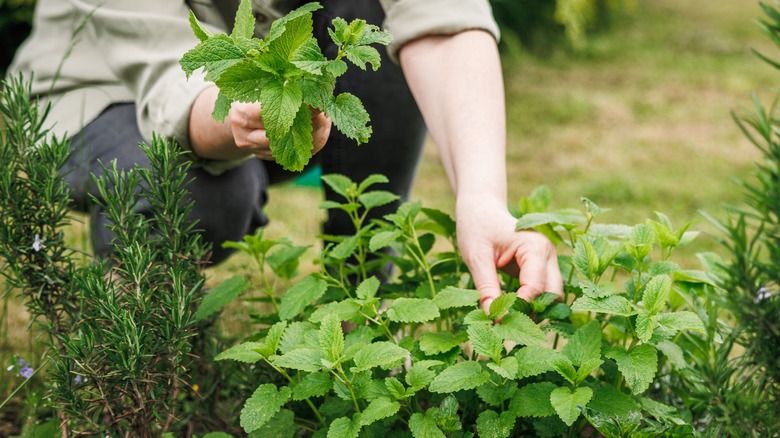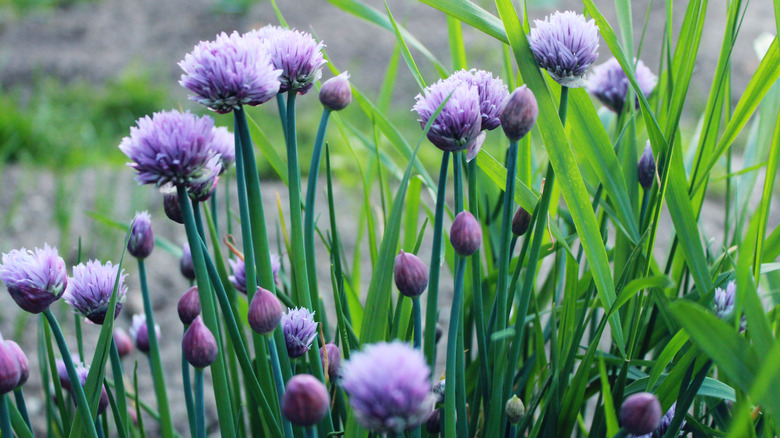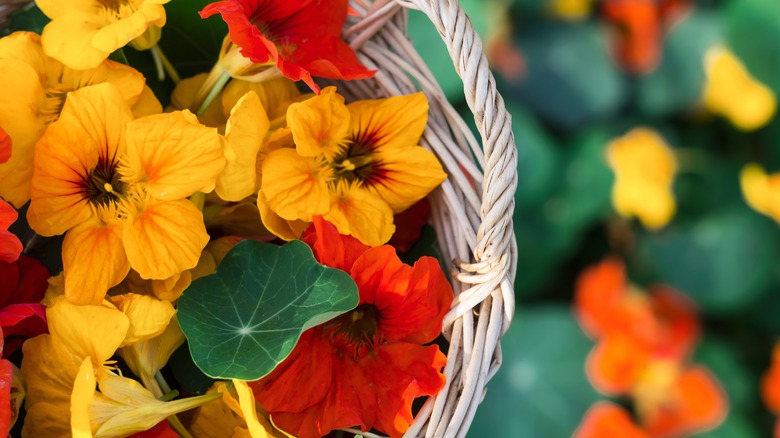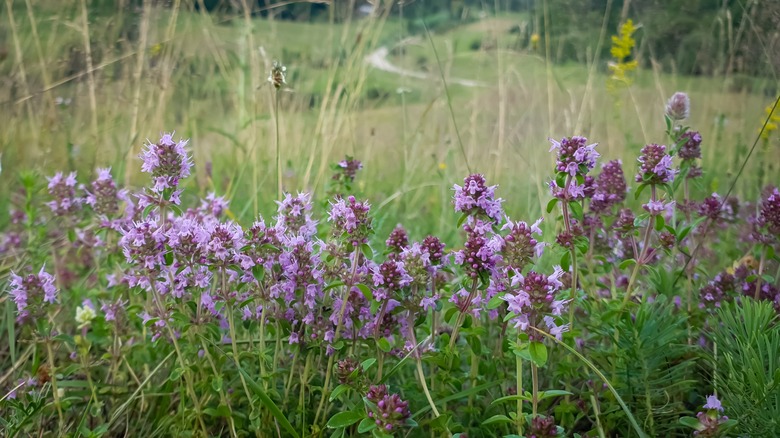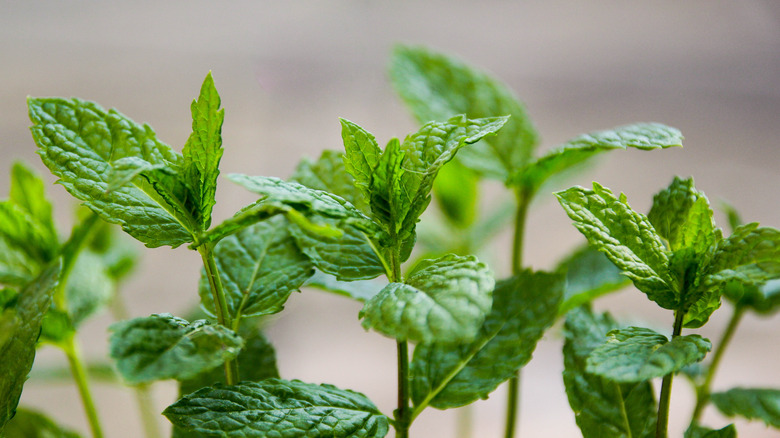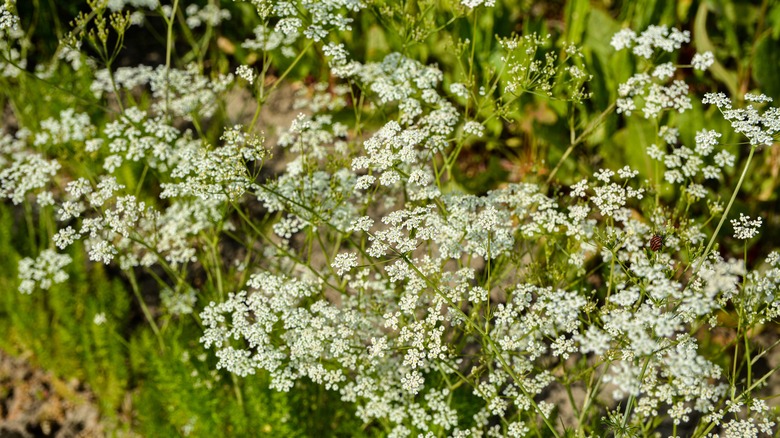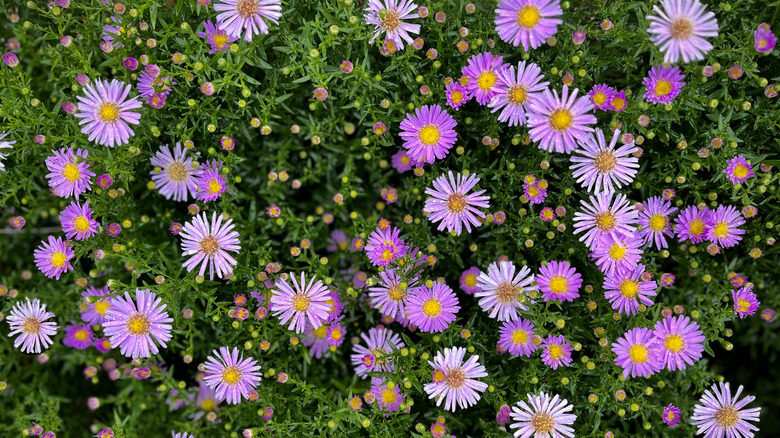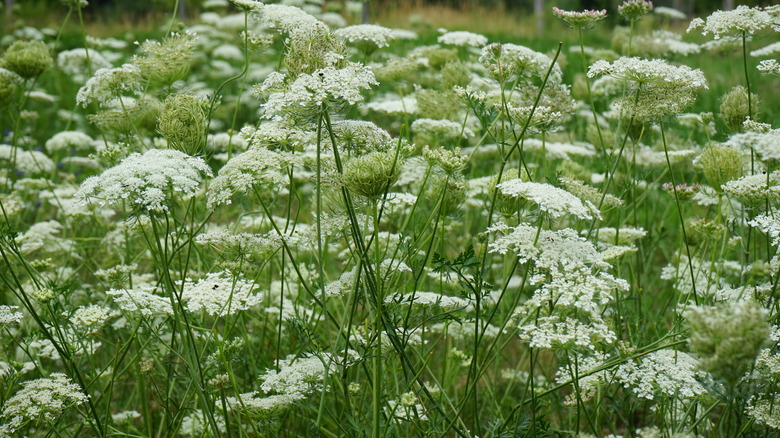Companion Plants That Will Safeguard Your Rosemary Plants From Pests
Rosemary (Salvia rosmarinus) is one of our favorite herbs to grow, thanks to its hardiness and ability to repel bugs from your garden. Plus, it's super easy to propagate rosemary, making it an easy plant to keep or give to a friend. Unfortunately, that doesn't mean that it's a foolproof plant. Rosemary is susceptible to several common garden pests like aphids, whiteflies, and thrips, just to name a few. These pests can wreak havoc on herbs and are particularly hard to control if you're not vigilant. The best way to ensure your rosemary plants stay healthy is by taking action and preventing pests from ever noticing them in the first place. This is where companion plants come in.
Luckily, there's a method that will keep those pests away and also allow your rosemary to remain herbicide and pesticide-free: adding more (different) plants to the garden, known as companion plants, right alongside the rosemary. Here are 10 easy to grow plants that will happily become BFFs to your rosemary and protect them from pests.
Why does companion planting work so well?
First, let's define what it is we're talking about here. Companion plants are plants that offer some kind of benefit to their neighbors, like nutrient sharing or pest management. One of the most famous groupings is known as the "Three Sisters:" corn, beans, and squash (or pumpkins). Growing these three together offers each plant the benefit of something the another plants have. Beans get to climb on the corn, which the beans repay by giving the corn a nitrogen boost. The squash or pumpkins act like a natural mulch that keeps weeds to a minimum, while getting some nice shady benefits from the corn and beans.
But the Three Sisters aren't the only plant groupings that work together well. Rosemary gives neighboring plants a ton of benefits: It's drought-resistant, so it doesn't take a lot of water, and it attracts beneficial insects like pollinators. All it asks in return is a little bit of pest control from its friends, which is what the featured plants below are more than happy to do for rosemary.
Grow chives next to rosemary to repel aphids
Chives (Allium schoenoprasum) are versatile, fast-growing herbs to grow in your garden next to rosemary. They're a hardy perennial that produce beautiful purple blooms, making them great as standalone ornamental plants. But their ability to act as a bodyguard cements their spot as one of the best companions for rosemary, warding off deer, rabbits, and aphids. Most deer and rabbits will be repelled by their strong scent, whereas aphids won't be able to smell the rosemary due to the strong scent of chives, making the pests overlook them. To make the chives more potent, crush a few leaves each morning (or whenever you're in your yard) to release their smell.
Chives are as relatively easygoing, care-wise as their rosemary neighbors. They can tolerate an array of soil conditions, but like well-draining soil the most. They even like the full sun that rosemary prefers, but can handle partial shade, too. Chive bulbs do best when planted in the fall, whereas rosemary gets its best start in the spring. You'll need to either decide which herb gets planted first or just buy young chive plants in the spring and save yourself the hassle. Younger chive plants won't be as drought-tolerant as rosemary so you may want to consider keeping one of them in containers until both plants mature.
Nasturtiums are excellent neighbors for rosemary
Are you a neglectful plant parent? If so, nasturtiums (Tropaeolum) are meant for you. They're gorgeous red, orange, or yellow flowers that will work their magic and keep aphids and whiteflies away from your rosemary plants. All they ask is that you leave them alone. Like, really alone.
Nasturtiums are the quintessential "diamond in the rough" kind of plant. They thrive in poor soil conditions and would prefer if you kept the fertilizer away from them since it just makes them more leafy than flowery. They'll handle rosemary's need for full sun just fine (though really harsh summers could make them wilt a little) and don't need a lot of water. They don't attract any serious pests or diseases. They'll self-seed without your help, attracting hummingbirds and butterflies, and will only get dramatic if you move them. They're also edible and may complement rosemary's flavor with their own taste profile that's considered a bit "peppery." So instead of trying to match growing conditions, just focus more on rosemary's care preferences, and it's likely any nasturtiums you plant will happily go along for the ride. As an extra tip, consider planting beans around your nasturtium and rosemary plants because they'll both repel beetles that normally love a good bean snack.
Thyme will help boost rosemary's natural resistances
Thyme (Thymus vulgaris) is a plant full of history. Its name may be derived from the Greek word "thymus," meaning "courage," and was used in medieval times as an emblem of bravery. Thanks to its storied history as a symbol of something you don't want to mess with, it's no surprise that thyme can be an excellent hardy friend for rosemary. Thyme has no major pest or disease problems and may even help boost rosemary's natural resistances, which is important if your plant gets weak from fighting off bugs or bacteria. Like rosemary, thyme is resistant to sesquiterpene lactones. These are chemicals that some plants will use to inhibit the growth of their neighbors, so that they can get the most sun and nutrients possible. Basically, it's biowarfare in the plant world, and thyme will hold strong against it with rosemary.
Thyme will happily grow in rosemary's preferred conditions. It likes full sun, soil with good drainage, and is drought-tolerant. It can get leggy as it gets older, so give it a good pruning to stimulate new growth. Thyme can also be harvested in the summer months at the same time as rosemary. Clearly, thyme was meant to be rosemary's twin or BFF.
Garlic will deter animals that love to snack on rosemary
If you've ever dealt with an aphid outbreak, you know that figuring out how to get rid of them isn't something you want to do again. Since aphids tend to like rosemary plants, you'll need to play defense by adding as many aphid-repelling plants as possible. That's where garlic (Allium sativum) comes into play. Its sulfur-rich compound structure and strong scent have been shown to repel not only aphids, but also other rosemary-eating nuisances like rabbits. Plus rosemary and garlic can bring more pollinators into your garden, too, making them an all-around awesome herb combo to grow.
Like rosemary, garlic does best in locations with well-draining soil that gets full sun. However, garlic prefers to be planted in the late fall, so it will need to be planted before rosemary. You can harvest them both during the summer months. Garlic bulbs are susceptible to rotting from overwatering, which makes them more than happy to live next to drought-tolerant plants like rosemary.
Mint attracts good bugs while repelling the bad ones
Mint is just wonderful. Spearmint (Mentha spicata), peppermint (Mentha piperita L.), chocolate mint (Mentha × piperita f. citrata) — whatever your preference — they're all great plants to have around. Not only do they make great herbs for cooking (and mojitos, let's be honest), but they can be a powerful ally to keep next to rosemary. Not only will most plants in the Mentha family repel nuisances like fleas and mites, but their strong aroma attracts beneficial insects that will prey on rosemary-loving pests.
Mint plants produce strong volatile organic chemicals (VOCs), which are essentially scents that act like throwing up the Bat Signal for predatory bugs, like the tomato bug (Nesidiocoris tenuis). The predators get a whiff of the VOCs, come to check out the plant to see what's up, and are pleasantly surprised when they find a tasty aphid or thrip population to snack on, both of which love rosemary. To grow rosemary and mint together, you'll most likely need to put mint in a separate container to keep it happy and under control. While mint plants like getting full sun like rosemary, they prefer moist soil, whereas rosemary likes it a little dry. Also, mint can get invasive quickly, growing like a weed if you're not careful. Thankfully, keeping it in a container will reign it in while still reaping its benefits.
Calendula can help keep pests away from rosemary
Calendula (Calendula officinalis), also known as "Pot Marigolds," is another flower with a storied history. Calendulas were popular plants to keep in England during Shakespeare's time and were used as medicinal plants as far back as the 12th century. They have some pest-repelling properties and are common companion plants for tomatoes, but aren't often talked about with rosemary. So why are we featuring them here? Because sometimes, companion planting can be a little more creative than just a buddy system; it can also ensure rosemary hides in plain sight from pests because of another brighter, more interesting plant. Master Gardener and president of the Josephine County Master Gardener Association chapter, Pam Zaklan, explains it best: "I plant calendulas alongside beds of...whatever plants aphids like to glob onto [like rosemary]. They'll attract the aphids and keep them from bothering the [rosemary]."
If you're using pot marigolds as a diversion, plant them as far away as possible from the rosemary, so that aphids never pick up their aroma. Calendulas can thrive in most soils and tolerate full sun or partial shade conditions. They like to get a drink of water after the first inch of soil is dry and need a little fertilizer boost once a month during their summer growing season.
Cilantro attracts beneficial insects that kill rosemary pests
Cilantro/coriander (Coriandrum sativum) is a bit of a confusing plant because of its dual names and uses. "Cilantro" refers to the plant's foliage, while "coriander" refers to its seeds, both of which are excellent spices for cooking. Whatever you want to call it, it's nonetheless an easygoing plant with extraordinary abilities. It has no significant insect or disease problems and is beloved by predatory bugs. Specifically, the spotless lady beetle (Cycloneda sanguinea L.) and hoverflies (Allograpta obliqua) love to feast on cilantro's nectar and pollen. But that's not the only thing they love to eat; both can wreak absolute havoc on aphid colonies, one of rosemary's nemeses, making them excellent neighbors for your salvia.
Cilantro prefers similar growing conditions to rosemary, so it should be easy to get them to play nice. It doesn't like being planted in areas with lots of rain or humidity and likes full sun to light shade. The herb can be a sprawler if you're not vigilant, so prune it back to a clump when it gets leggy. If you make it super happy, you'll be rewarded with white, pink, or pale lavender flowers that look absolutely stunning next to rosemary's solid purple blooms.
Sunflowers attract lady beetles, which prey on rosemary-loving pests
At first, pairing sunflowers (Helianthus annuus) and rosemary might seem like a bad match. Sunflowers can reach as high as 10 feet, whereas rosemary typically taps out around 5 feet. Rosemary is hardy only in USDA zones 8a-10b, while sunflowers grow in almost any zone you let them. Yet, despite their differences, they enjoy similar growing conditions: full sun, well-draining soil, and not too much water. Plus, sunflowers bring a lot to the table for keeping your rosemary pest-free. Not only do pollinators absolutely love them, but sunflowers attract lady beetles (Coccinellidae), which prey on whiteflies and aphids that love to munch on rosemary springs.
Planting sunflowers and rosemary together takes a little planning, though. First, you'll need to consider how much light rosemary will get if a dense sunflower canopy grows. Remember that rosemary likes at least six hours of sun, making it hard to compete with sunflowers if they're planted too closely together. Also, all parts of a sunflower contain sesquiterpene lactones (SL) chemicals, which are a sneaky little trick that inhibits the growth of plants around them. Luckily, rosemary is immune, so consider planting a perimeter of rosemary around your sunflowers to prevent SL from migrating to the rest of your garden. That way, rosemary gets help from the beneficial beetles, and sunflowers get boxed into a nice little cluster.
Asters attract spider mite predators, one of rosemary's nemeses
Asters are lovely, daisy-like flowers that give your garden one last pop of color in the fall. There are over 600 types of aster, but you'll typically find the most common to be either the New England (Symphyotrichum novae-angliae) or New York (Symphyotrichum novi-belgii) cultivars. Both of these cultivars are showy and can reach anywhere from 3 to 7 feet tall, making them a nice complement to rosemary's 5 foot max height. But besides being tall buddies, asters are great for rosemary, because they like to bring friends. Specifically, predatory beetles, which will eagerly decimate any aphid and whitefly colonies that are attracted to rosemary.
Whether you choose the novae-angliae or novi-belgii strain, you'll find that they will go with the flow for growing conditions, as both cultivars are considered low-maintenance. Like rosemary, asters love full sun and do best in well-draining soil. Asters may need a little more water than rosemary, so you might want to consider planting them in pots or separating them ever so slightly to ensure the water balance is just right. Give your aster plants a few feet of space for the best growth. As they grow, asters may begin to bend under the weight of their blooms, so give them a few garden stakes for support.
Queen Anne's Lace attracts beneficial insects for rosemary
Despite it looking nothing like its root vegetable cousins, Queen Anne's Lace (Daucus carota) is actually part of the carrot family and is sometimes known as "wild carrot." This delicate flower is such a prolific and hardy grower that it's sometimes considered a weed, but we love it anyway. Queen Anne's Lace originally hails from Europe, hitched a ride over to the U.S., and planted itself anywhere we let it: roadsides, overgrown fields, ditches; you name it, and Queen Anne's Lace is probably there. But it's not just a hardy grower, it also attracts parasitic wasps like tiphia vernalis , green lacewings, and siphids (hoverflies). These beneficial insects will hang out on the umbrella-like groups of blooms in wait and attack aphid colonies, destroying their chance to invade your rosemary plants.
Queen Anne's Lace doesn't need much in terms of care, since it will grow nearly anywhere that gets full sun, but you may want to keep it confined to containers to prevent it from aggressively overtaking your garden. Also, some people may develop a skin sensitivity to it, especially if they're allergic to celery, so keep that in mind. Don't worry if your plant doesn't bloom the first year; it's a biennial, so it needs a year to get situated before spending the energy to produce flowers.

